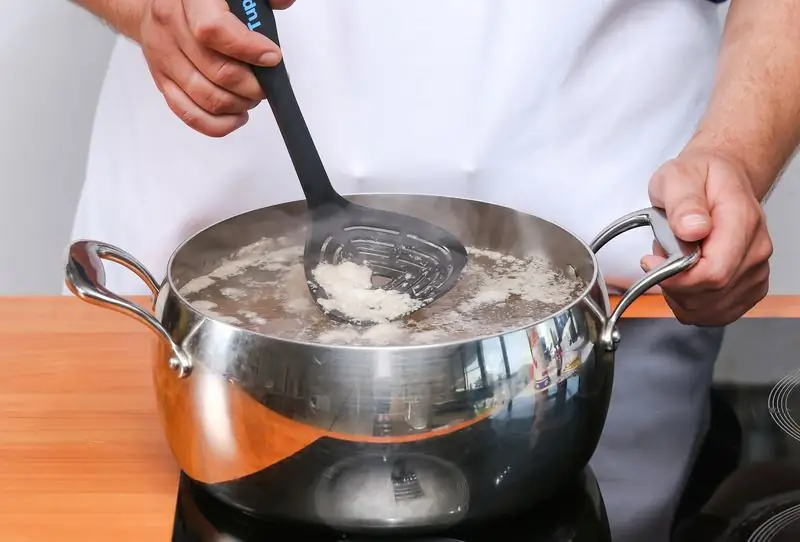
Table of contents:
- Author Bailey Albertson [email protected].
- Public 2023-12-17 12:53.
- Last modified 2025-01-23 12:41.
Where does the foam come from when cooking meat and why should it be removed

Our grandmothers also taught us to remove the foam from the broth when cooking meat. Why it was needed, they usually did not tell: it is just as it should be, and that's it. So why does foam appear on the surface during cooking and is it really necessary to get rid of it - we'll talk about this today.
What is the foam generated when cooking meat
Meat is a protein product, in addition, it is high in fat and even bone particles. Protein tends to curdle at high temperatures. During cooking, most of it remains in the meat, but what is on the surface and close to it is released into the water, where it turns into a light foam that floats up.

The foam that comes from cooking meat is curdled protein
Fresh, properly cut meat gives a light foam - white or slightly grayish. Dark gray or brown foam indicates that there is a lot of blood in the meat. It is she who, curled up, gives such a dirty color. In addition, the meat can be poorly washed. All the litter remaining on it will be pushed onto the surface of the broth by coagulated protein.
Poultry meat forms the least foam, but on condition that it is store-bought. Domestic chicken, duck, turkey are rarely dry and lean. The owners feed the birds well, so that they not only carry eggs, but also then be tasty. For example, when I cook homemade chicken soup, I have to stand over the saucepan until the broth starts to boil so that not a single gram of froth passes through. You don't have to bother with store-bought chicken.

Shop chicken produces very little foam.
Beef ranks second in terms of the amount of foam formed, and pork takes the first place. Still, there is a dependence on the ratio of proteins and fats: the fatter the meat, the more intensively the protein is released into the water. But from my own experience, I can say that dark, brown foam appears more often on beef broth.
Do you need to remove the foam and why
Curdled protein will not do any harm to health. The only reason it is removed from the pan is because it looks unaesthetic. As soon as the water boils, the foam turns into unpleasant-looking flakes of various sizes, which are not so easy to catch. The broth becomes dark and cloudy. Therefore, the foam is removed immediately when it appears, until the water boils.
The dark, brown foam formed from the blood in the meat is best removed. Although it is not more harmful than usual, clotted blood has a specific taste that not everyone will like.

If the meat is fresh and clean, it is not necessary to skim the foam when cooking it.
It is imperative to remove foam contaminated with small particles of bone or litter from poorly washed meat. If you doubt the origin of the meat (for example, it was stored for a long time or, perhaps, it was subjected to chemical processing), it is better to proceed as follows: wait for the broth to boil without removing the foam, and drain it. Fill the meat with fresh water and cook again.
If you still missed the moment and the foam curled into flakes, just strain the broth through cheesecloth or a sieve. You can also pour a glass of cold water into the pot; from this, foam flakes will quickly rise to the surface, and you can easily collect them.
How to reduce the amount of froth formed when cooking broth
To ensure that the appearance of foam in the broth is not critical, follow simple rules.
- Place raw meat in boiling water instead of cold. When heated quickly, the protein curls up almost immediately inside the piece and does not have time to get out.
-
During the boil phase, shortly before the foam forms, place the peeled onion, whole or cut in half, into the broth. The protein flakes will stick to it. At the same time, the broth will become more aromatic.

Onion and meat in a saucepan Add an onion to boiled meat to reduce foam
- A raw egg, hammered into the broth after the formation of a protein foam, acts on the same principle as an onion.
- Pay attention to the quality of the meat. If it is young, there will be much less foam from it than from the old one. And, of course, thoroughly rinse meat, even homemade ones.
Video: is it worth removing the foam when cooking meat
As you can see, foam in meat broth does not pose any danger to our health (if we are not talking about dirt and chemicals). It makes no sense to speak unequivocally about whether to leave it or it is better to remove it. In the case when it is important for you that the broth is light and transparent, it is advisable to get rid of the foam in time. And if the aesthetic appearance is not fundamental - let it remain, it will not spoil the taste. Enjoy your meal!
Recommended:
What To Do If, After Flashing Android, The Phone Or Tablet Does Not Turn On, Does Not See The Network, Does Not Charge

Why does my smartphone or tablet not work after changing the Android version. How to troubleshoot various problems. How to properly reflash a device
Why On Windows 10 The Start Button Does Not Work And The Main Menu Does Not Open

The most common problems in the "Start" menu on Windows 10. The reasons for the appearance. Solutions: universal and for specific cases
Why Skim The Jam And Do You Need To Remove It When Cooking

Why remove the foam from the jam when cooking and whether it needs to be done. Ways to reduce foaming
Potato Pancakes With Minced Meat: A Step-by-step Recipe For Sorcerers With Meat In A Pan, Photo And Video

How to cook potato pancakes with minced meat. step by step recipe with photos, additional fillings
Why Does A Man's Mistress Dream And What Does It Mean To Be Her In A Dream For A Woman (according To Different Dream Books)

Why is the mistress dreaming. How sleep is interpreted for men and women. Why be a mistress in a dream according to dream books
